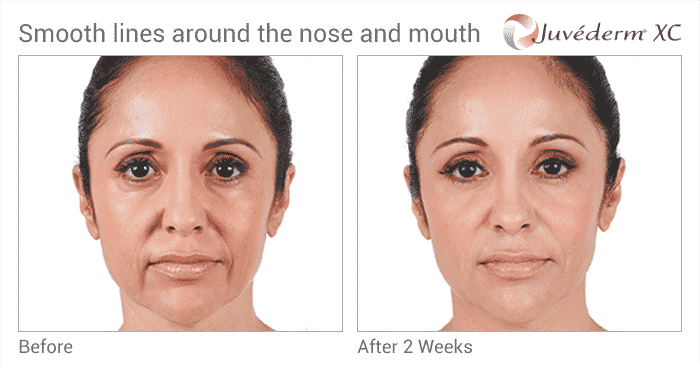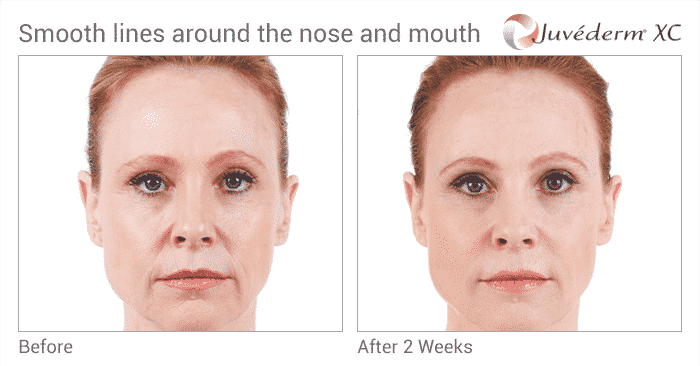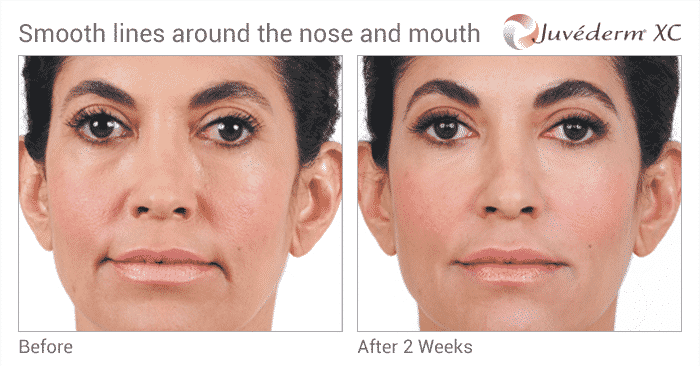Kiss those lines goodbye with the Juvederm family of products. Juvederm has a dermal filler for every application.
Juvederm is a smooth consistency gel made of hyaluronic acid—a naturally occurring substance in your skin that helps to add volume and hydration. Juvéderm is placed under the skin to instantly restore your skin’s volume and smooth away facial wrinkles and folds. Juvéderm provides a smooth, natural look and feel—so everyone will notice (but no one will know)! There are several types and consistencies of Juvederm, we will help you determine which is best for your skin.
* Individual Results and Patient Experience May Vary
What is the difference between Juvederm, Juvederm Ultra and Juvederm Voluma?
It can often get confusing as to what Juvederm product is best for what procedure. Dominique sat down with us and gave us a quick overview of the Juvederm family of products and what each one is best for.
You may also call one of our patient care coordinators at 206-935-5689 and we will be happy to assist you in scheduling.
What is the difference between BOTOX and JUVÉDERM?
BOTOX Cosmetic and JUVÉDERM XC are two possible ways to treat moderate to severe facial lines and wrinkles. Both are non-surgical, but they work differently:
- BOTOX Cosmetic: Botox is injected beneath the skin’s surface to target the underlying muscle activity which is one of the causes of moderate to severe frown lines between the brows and crow’s feet. BOTOX Cosmetic temporarily reduce the activity of those muscles.
- JUVÉDERM: Juvéderm is a family of dermal fillers that are injected into the skin to temporarily smooth moderate to severe wrinkles such as those around the nose and mouth. There is a

10 Tips to Minimize the Risk of Bruising After Wrinkle Reducers & Dermal Fillers
Cosmetic injectable treatments, such as wrinkle reducers and dermal fillers, can work wonders in filling out lines and wrinkles, but they may cause temporary bruising and swelling. Many patients ask us how to minimize or prevent bruising, and the good news is that there's a lot you can do before and after your appointment to minimize any unsightly coloring – and in some cases, prevent it altogether.
No injector can guarantee that you won't bruise from injectable treatments, but to avoid serious side effects, it's always best to go to the most expert injector in your area. To be on the safe side, don't plan any special events for at least 2 weeks after your injectable appointment. Remember, treatments can take 1 to 2 weeks for results to fully settle in, so unless something is really off, most minor problems will resolve with patience.
If you're just having a wrinkle reducer treatment (Botox, Dysport, or Xeomin), these suggestions are still good to follow, even though bruising is less common. However, dermal fillers like Juvederm, Restylane, Radiesse, Sculptra, and Bellafill are slightly more invasive, and following these instructions will help prevent bruises or reduce their appearance more quickly. Please visit https://wellmedicalarts.com/pre-and-post-injectable-instructions/ for additional information and videos.
Here are a few pre and post-treatment tips that can help you avoid unnecessary bruising:
-
Avoid Aspirin & NSAIDs
-
Avoid Wine & Alcohol
-
Avoid Green Tea, Vitamin E, and Herbal Supplements
-
Skip the Gym
-
Choose a Qualified Injector
-
Apply Ice
-
Use Numbing Cream
-
Consider Anti-Bruising Supplements such as Arnica Montana
-
Practice Sun Protection
-
Plan Accordingly
If you do bruise, continue icing the affected areas, take Arnica as directed, and use a high-level concealer to hide temporary bruises. For lip bruises, lipstick can do the trick. The intensity and duration of your filler or Botox side effects will depend on the treatment aggressiveness and your individual healing characteristics, but they normally last for one to two weeks after the treatment.
* Individual Results and Patient Experience May Vary
Join our email list to be the first to get notified about current promotions and super informative educational events.
Important safety information, including Boxed warning for Botox cosmetic.
BOTOX® Cosmetic and JUVÉDERM® XC are two possible ways to treat moderate to severe facial lines and wrinkles. Both are non-surgical, but they work differently:
- BOTOX® Cosmetic: Injected beneath the skin’s surface to target the underlying muscle activity which is one of the causes of moderate to severe frown lines between the brows and crow’s feet. BOTOX®Cosmetic temporarily reduce the activity of those muscles.
- JUVÉDERM® XC: Injected into the skin to temporarily smooth moderate to severe wrinkles such as those around the nose and mouth.*†
Please see Important Safety Information, including Boxed Warning, for BOTOX® Cosmetic below, or click here.
* In the United States, JUVÉDERM® XC is indicated for correction of moderate to severe facial wrinkles and folds (such as nasolabial folds).
† This includes all JUVÉDERM® XC injectable gel formulations.Learn more about Juvéderm here: http://www.juvederm.com/faq
JUVÉDERM® XC Important Information
Indication
JUVÉDERM® injectable gel is injected into areas of facial tissue where moderate to severe facial
wrinkles and folds occur to temporarily add volume to the skin, which may give the appearance of a
smoother surface.
IMPORTANT SAFETY INFORMATION
Your physician will ask about your medical history to determine if you are an appropriate candidate for
treatment. The product should not be used in patients who have:
• Severe allergies marked by a history of anaphylaxis or history or presence of multiple
severe allergies
• A history of allergies to lidocaine or Gram-positive bacterial proteins
JUVÉDERM® XC IMPORTANT SAFETY INFORMATION (continued)
The safety and effectiveness for the treatment of areas other than facial wrinkles and folds (such as
lips) have not been established in controlled clinical studies.
The following are important treatment considerations for you to discuss with your physician and
understand in order to help avoid unsatisfactory results and complications:
• Patients who are using substances that can prolong bleeding, such as aspirin or ibuprofen, as
with any injection, may experience increased bruising or bleeding at injection site. You should
inform your physician before treatment if you are using these types of substances
• If laser treatment, chemical peeling, or any other procedure based on active dermal response
is considered after treatment with JUVÉDERM®, there is a possible risk of an inflammatory
reaction at the treatment site
• JUVÉDERM® injectable gel should be used with caution in patients on immunosuppressive
therapy, or therapy used to decrease the body’s immune response, as there may be an
increased risk of infection
• The safety for use during pregnancy, in breast-feeding females, or in patients under 18 years
has not been established
• The safety in patients with a history of excessive scarring (eg, hypertrophic scarring and keloid
formations) and pigmentation disorders has not been studied
Most side effects are mild or moderate in nature, and their duration is short lasting (7 days or less).
The most common side effects include, but are not limited to, temporary injection-site reactions such
as: redness, pain/tenderness, firmness, swelling, lumps/bumps, bruising, itching, and discoloration.
As with all skin-injection procedures, there is a risk of infection.
To report a problem with JUVÉDERM®, please call Allergan Product Surveillance at 1-800-624-4261.
For more information, please see the About Safety page at www.juvederm.com or call the
Allergan Product Support line at 1-800-433-8871.
JUVÉDERM® injectable gel is available by prescription only.




